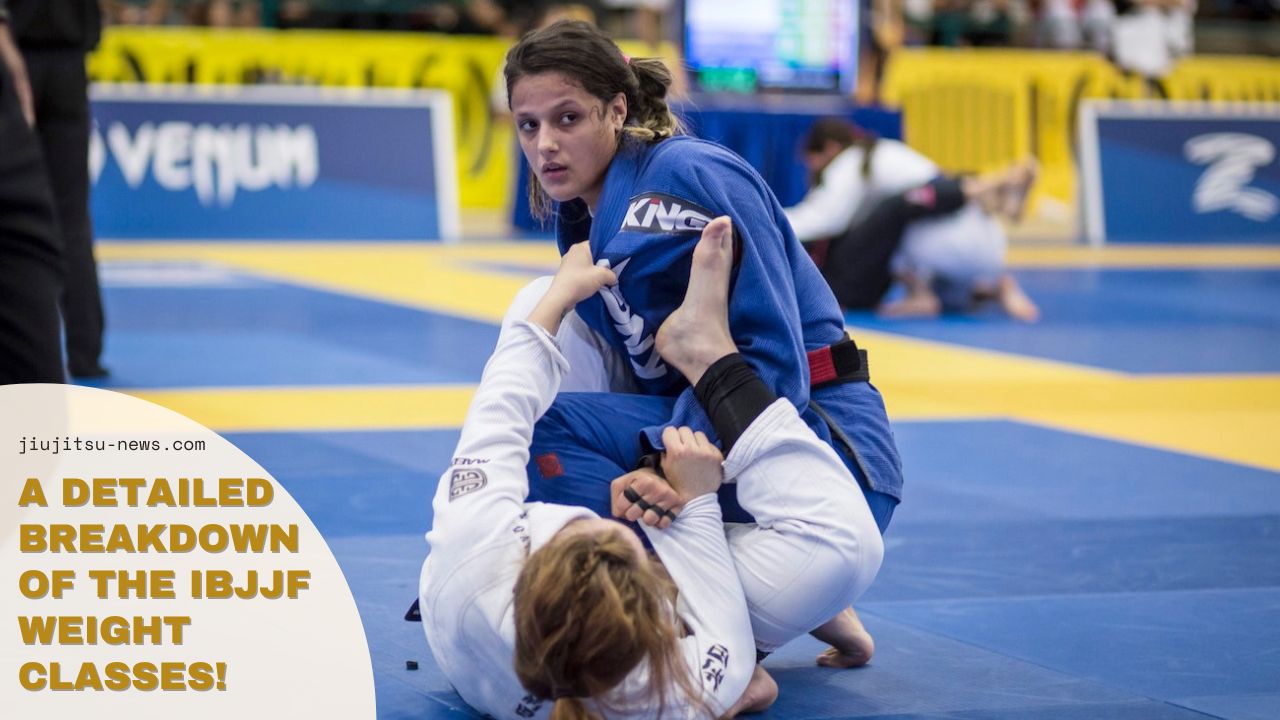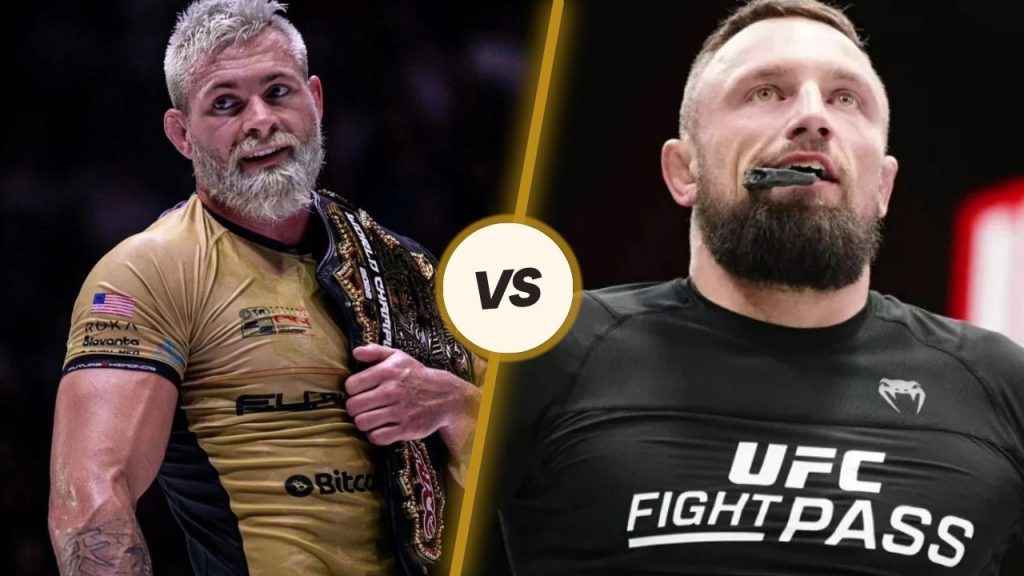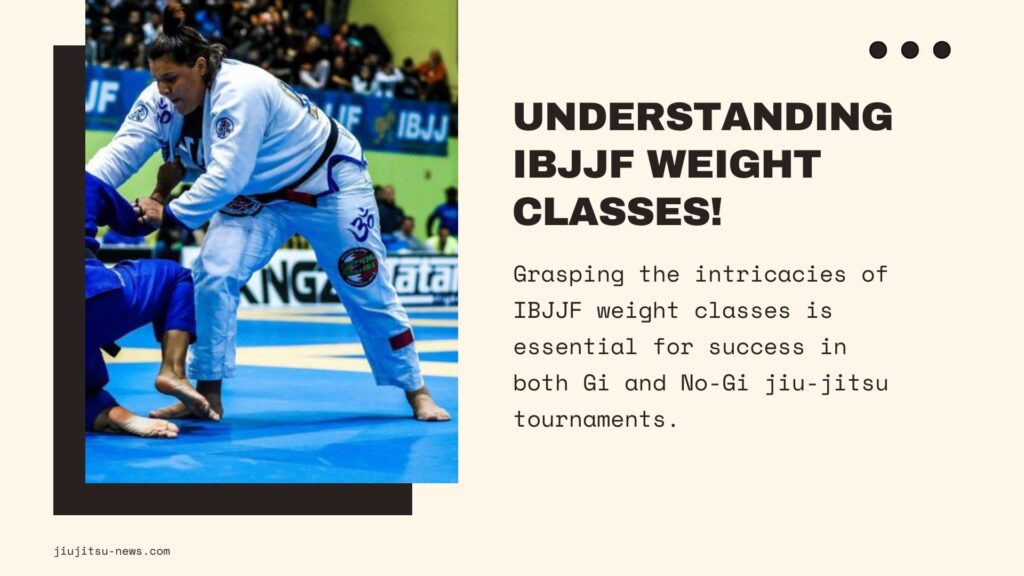
Excelling in jiu-jitsu competitions becomes significantly more manageable when you grasp the intricacies of the IBJJF weight classes.
Understanding these specific weight categories will set you up for success in the top Gi or No-Gi IBJJF tournaments.
Read on for a detailed guide to the weight divisions for adult men, women, and youth categories. You will gain essential insights to step onto the tournament mat with confidence and strategic advantage.
The Different IBJJF Weight Classes

IBJJF competitions are inclusive, accommodating athletes of all ages and skill levels through its comprehensive range of weight and age categories.
Whether you are a young enthusiast or a seasoned adult, there is a division that matches your capability. The main weight divisions in IBJJF competitions are:
- Male Adults/Masters Gi
- Female Adults/Masters Gi
- Male Juvenile Gi
- Female Juvenile Gi
- Male Adults/Masters No Gi
- Female Adults/Masters No Gi
- Male Juvenile No Gi
- Female Juvenile No Gi
The categories are carefully separated to ensure fair and competitive matchups.
Newcomers often find the variety of options overwhelming, especially since Gi and No-Gi tournaments have slightly different weight allowances. Let’s explore these categories in more detail.
Male Adults/Masters Gi
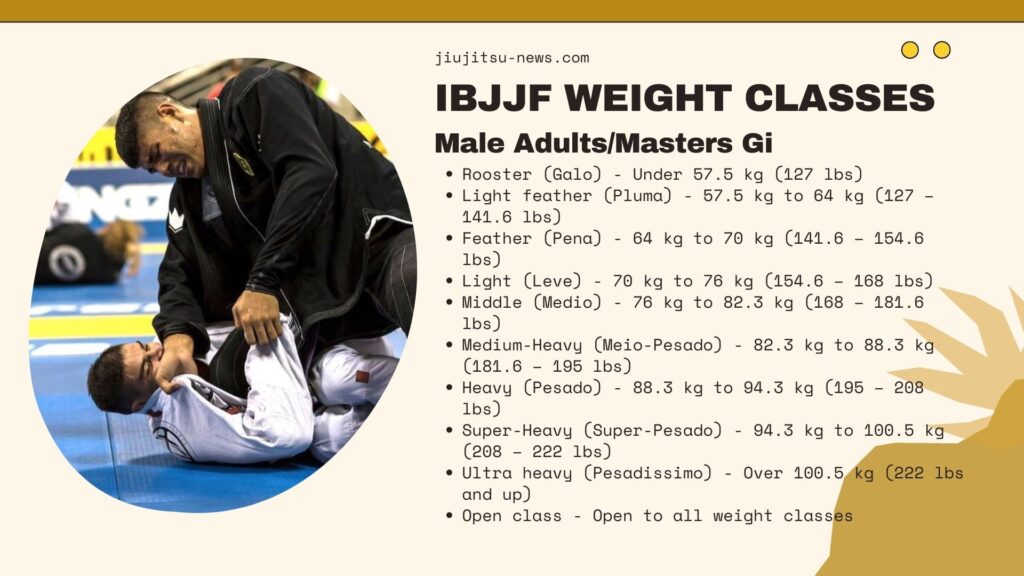
The weight classes for the IBJJF Gi competitions for male adults and masters are meticulously defined, with each category accommodating a specific weight range.
The Gi weight classes are slightly lighter compared to the No-Gi divisions, reflecting the additional weight of the Gi outfit. Here are the detailed weight classes for Male Adults/Masters in GI competitions:
| IBJJF Male Adults/Master Gi Division | Weight Limit |
|---|---|
| Rooster (Galo) | Under 57.5 kg (127 lbs) |
| Light feather (Pluma) | 57.5 kg to 64 kg (127 – 141.6 lbs) |
| Feather (Pena) | 64 kg to 70 kg (141.6 – 154.6 lbs) |
| Light (Leve) | 70 kg to 76 kg (154.6 – 168 lbs) |
| Middle (Medio) | 76 kg to 82.3 kg (168 – 181.6 lbs) |
| Medium-Heavy (Meio-Pesado) | 82.3 kg to 88.3 kg (181.6 – 195 lbs) |
| Heavy (Pesado) | 88.3 kg to 94.3 kg (195 – 208 lbs) |
| Super-Heavy (Super-Pesado) | 94.3 kg to 100.5 kg (208 – 222 lbs) |
| Ultra heavy (Pesadissimo) | 0ver 100.5 kg (222 lbs and up) |
| Open class | Open to all weight classes |
Female Adults/Masters Gi
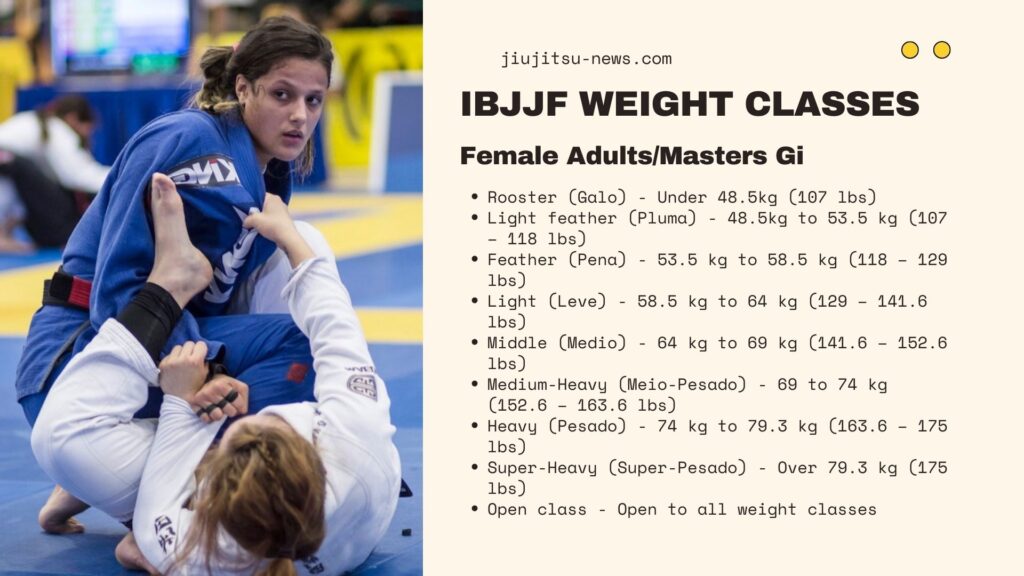
Female competitors in GI competitions also have specific weight divisions designed to ensure that athletes compete against others of similar body weight. Just like the male divisions, these classes account for the weight of the Gi.
Here’s a breakdown of the weight limits for Female Adults/Masters Gi divisions:
| IBJJF Gi Female Weight Division | Weight Limit |
|---|---|
| Rooster (Galo) | Under 48.5kg (107 lbs) |
| Light feather (Pluma) | 48.5kg to 53.5 kg (107 – 118 lbs) |
| Feather (Pena) | 53.5 kg to 58.5 kg (118 – 129 lbs) |
| Light (Leve) | 58.5 kg to 64 kg (129 – 141.6 lbs) |
| Middle (Medio) | 64 kg to 69 kg (141.6 – 152.6 lbs) |
| Medium-Heavy (Meio-Pesado) | 69 to 74 kg (152.6 – 163.6 lbs) |
| Heavy (Pesado) | 74 kg to 79.3 kg (163.6 – 175 lbs) |
| Super-Heavy (Super-Pesado) | Over 79.3 kg (175 lbs) |
| Open class | Open to all weight classes |
Male Juvenile Gi
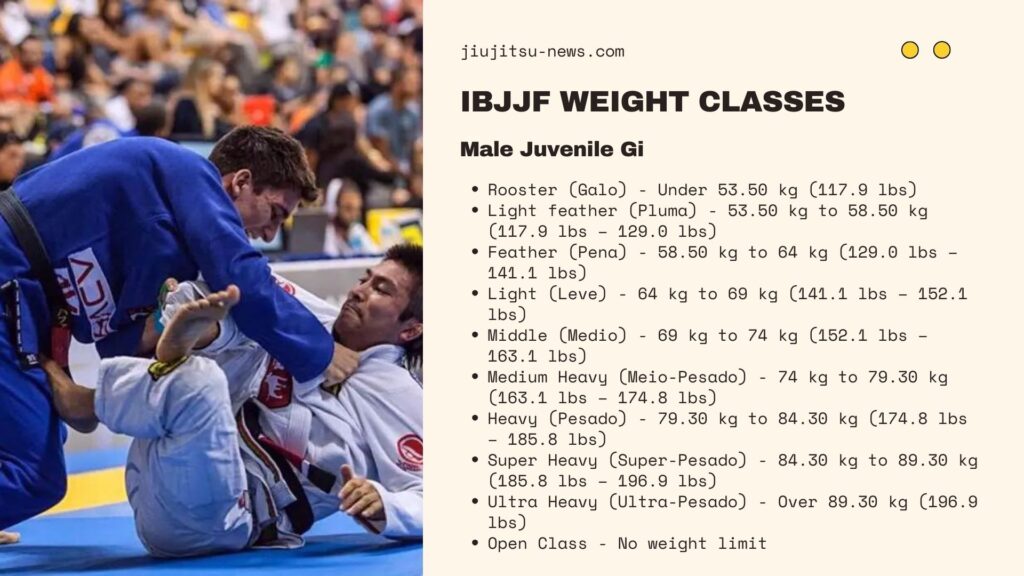
In Gi competitions, young male athletes have tailored weight classes. These classes foster competitive fairness among younger participants, who are still growing and developing physically.
Here are the weight classes for Male Juvenile Gi competitors:
| Male Juvenile Gi IBJJF Classes | Weight limit |
|---|---|
| Rooster (Galo) | Under 53.50 kg (117.9 lbs) |
| Light feather (Pluma) | 53.50 kg to 58.50 kg (117.9 lbs – 129.0 lbs) |
| Feather (Pena) | 58.50 kg to 64 kg (129.0 lbs – 141.1 lbs) |
| Light (Leve) | 64 kg to 69 kg (141.1 lbs – 152.1 lbs) |
| Middle (Medio) | 69 kg to 74 kg (152.1 lbs – 163.1 lbs) |
| Medium Heavy (Meio-Pesado) | 74 kg to 79.30 kg (163.1 lbs – 174.8 lbs) |
| Heavy (Pesado) | 79.30 kg to 84.30 kg (174.8 lbs – 185.8 lbs) |
| Super Heavy (Super-Pesado) | 84.30 kg to 89.30 kg (185.8 lbs – 196.9 lbs) |
| Ultra Heavy (Ultra-Pesado) | Over 89.30 kg (196.9 lbs) |
| Open Class | No weight limit |
Female Juvenile Gi
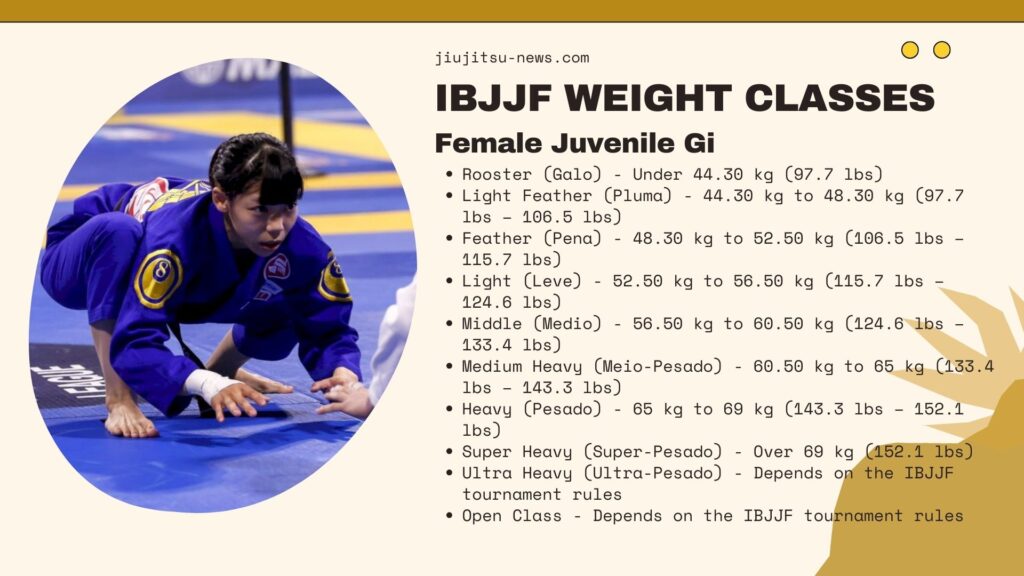
Like the male juvenile classes, young female competitors have specific weight brackets in Gi competitions.
These divisions ensure that competitions are fair and balanced for all participants, providing a supportive environment for young athletes to develop their skills.
Here are the weight classes for Female Juvenile Gi participants:
| IBJJF Female Juvenile Gi Classes | Weight Limit |
|---|---|
| Rooster (Galo) | Under 44.30 kg (97.7 lbs) |
| Light Feather (Pluma) | 44.30 kg to 48.30 kg (97.7 lbs – 106.5 lbs) |
| Feather (Pena) | 48.30 kg to 52.50 kg (106.5 lbs – 115.7 lbs) |
| Light (Leve) | 52.50 kg to 56.50 kg (115.7 lbs – 124.6 lbs) |
| Middle (Medio) | 56.50 kg to 60.50 kg (124.6 lbs – 133.4 lbs) |
| Medium Heavy (Meio-Pesado) | 60.50 kg to 65 kg (133.4 lbs – 143.3 lbs) |
| Heavy (Pesado) | 65 kg to 69 kg (143.3 lbs – 152.1 lbs) |
| Super Heavy (Super-Pesado) | Over 69 kg (152.1 lbs) |
| Ultra Heavy (Ultra-Pesado) | Depends on the IBJJF tournament rules |
| Open Class | Depends on the IBJJF tournament rules |
Male Adults/Masters No-Gi

The No Gi competitions remove the weight of the Gi, leading to slightly different weight classes.
Here are the specific weight limits for Male Adults/Masters competing in No Gi events:
| Male Adults/Masters No-Gi IBJJF Weight Classes | Weight Limit |
|---|---|
| Rooster (Galo) | Under 55.6 kg (122.6 lbs) |
| Light feather (Pluma) | 55.6 kg to 61.7 kg (122.6 – 136 lbs) |
| Feather (Pena) | 61.7kg to 67.5 kg (136 – 149 lbs) |
| Light (Leve) | 67.5 kg to 73.5 kg (149 – 162.6 lbs) |
| Middle (Medio) | 73.5 kg to 79.6 kg (162.6 – 175.6 lbs) |
| Medium-Heavy (Meio-Pesado) | 79.6 kg to 85.5 kg (175.6 – 188.6 lbs) |
| Heavy (Pesado) | 85.5 kg to 91.6 kg (188.6 – 202 lbs) |
| Super-Heavy (Super-Pesado) | 91.6 kg to 97.5 kg (202 – 215 lbs) |
| Ultra heavy (Pesadissimo) | Over 97.5 kg (215 lbs) |
| Open class | Open to all weight classes |
Female Adults/Masters No-Gi

There are no Gi competitions for female adults, and masters also feature adjusted weight classes to account for the Gi’s absence.
These are the specific weight limits for each class:
| Female Adults/Masters No-Gi IBJJF Weight Classes | Weight Limit |
|---|---|
| Rooster (Galo) | Under 46.7kg (103 lbs) |
| Light feather (Pluma) | 46.7kg to 51.7 kg (103 – 114 lbs) |
| Feather (Pena) | 51.7 kg to 56.7 kg (114 – 125 lbs) |
| Light (Leve) | 56.7 kg to 61.6 kg (125 – 136 lbs) |
| Middle (Medio) | 61.6 kg to 66.7 kg (136 – 147 lbs) |
| Medium-Heavy (Meio-Pesado) | 66.7 to 71.6 kg (147 – 158 lbs) |
| Heavy (Pesado) | 71.6 kg to 76.6 kg (158 – 169 lbs) |
| Super-Heavy (Super-Pesado) | Over 76.6 kg (169 lbs) |
| Open class | Open to all weight classes |
Male Juvenile No-Gi
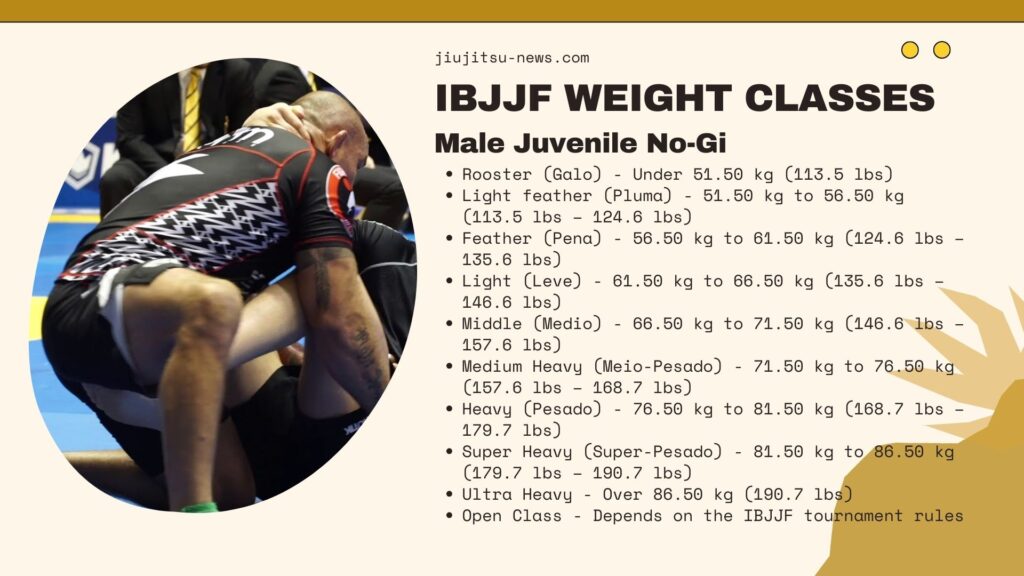
Young male athletes competing without the Gi are categorized in the following weight classes, ensuring that they face competitors of a similar size and weight:
| Male Juvenile No-Gi Classes | Weight Limit |
|---|---|
| Rooster (Galo) | Under 51.50 kg (113.5 lbs) |
| Light feather (Pluma) | 51.50 kg to 56.50 kg (113.5 lbs – 124.6 lbs) |
| Feather (Pena) | 56.50 kg to 61.50 kg (124.6 lbs – 135.6 lbs) |
| Light (Leve) | 61.50 kg to 66.50 kg (135.6 lbs – 146.6 lbs) |
| Middle (Medio) | 66.50 kg to 71.50 kg (146.6 lbs – 157.6 lbs) |
| Medium Heavy (Meio-Pesado) | 71.50 kg to 76.50 kg (157.6 lbs – 168.7 lbs) |
| Heavy (Pesado) | 76.50 kg to 81.50 kg (168.7 lbs – 179.7 lbs) |
| Super Heavy (Super-Pesado) | 81.50 kg to 86.50 kg (179.7 lbs – 190.7 lbs) |
| Ultra Heavy | Over 86.50 kg (190.7 lbs) |
| Open Class | Depends on the IBJJF tournament rules |
Female Juvenile No-Gi
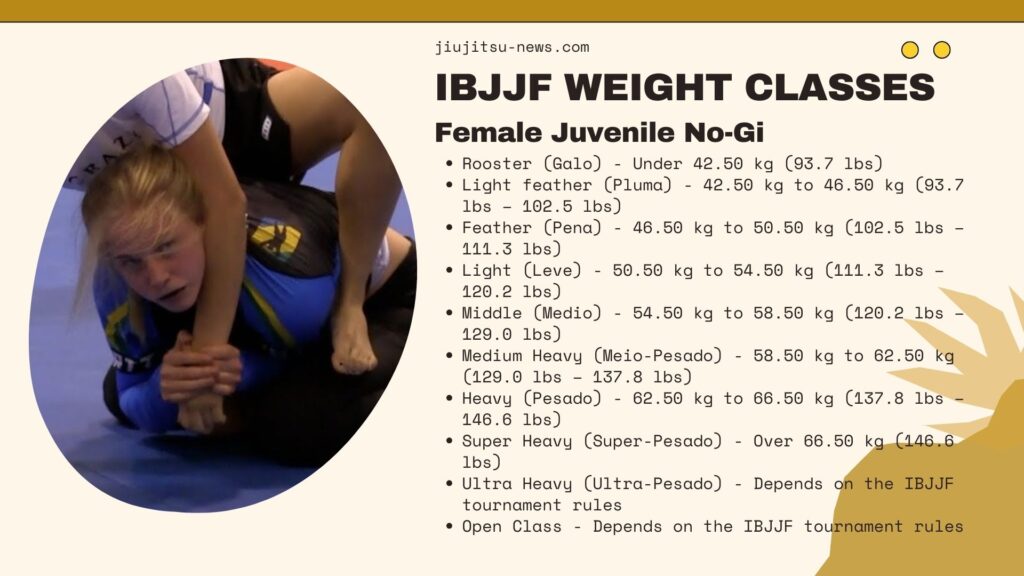
The weight classes for young female athletes in No Gi competitions are designed to maintain competitive balance and fairness, providing a platform for skill development in a supportive environment:
| Female Juvenile No-Gi IBJJF Classes | Weight Limit |
|---|---|
| Rooster (Galo) | Under 42.50 kg (93.7 lbs) |
| Light feather (Pluma) | 42.50 kg to 46.50 kg (93.7 lbs – 102.5 lbs) |
| Feather (Pena) | 46.50 kg to 50.50 kg (102.5 lbs – 111.3 lbs) |
| Light (Leve) | 50.50 kg to 54.50 kg (111.3 lbs – 120.2 lbs) |
| Middle (Medio) | 54.50 kg to 58.50 kg (120.2 lbs – 129.0 lbs) |
| Medium Heavy (Meio-Pesado) | 58.50 kg to 62.50 kg (129.0 lbs – 137.8 lbs) |
| Heavy (Pesado) | 62.50 kg to 66.50 kg (137.8 lbs – 146.6 lbs) |
| Super Heavy (Super-Pesado) | Over 66.50 kg (146.6 lbs) |
| Ultra Heavy (Ultra-Pesado) | Depends on the IBJJF tournament rules |
| Open Class | Depends on the IBJJF tournament rules |
Key Differences: Gi Weight Classes vs. No-Gi
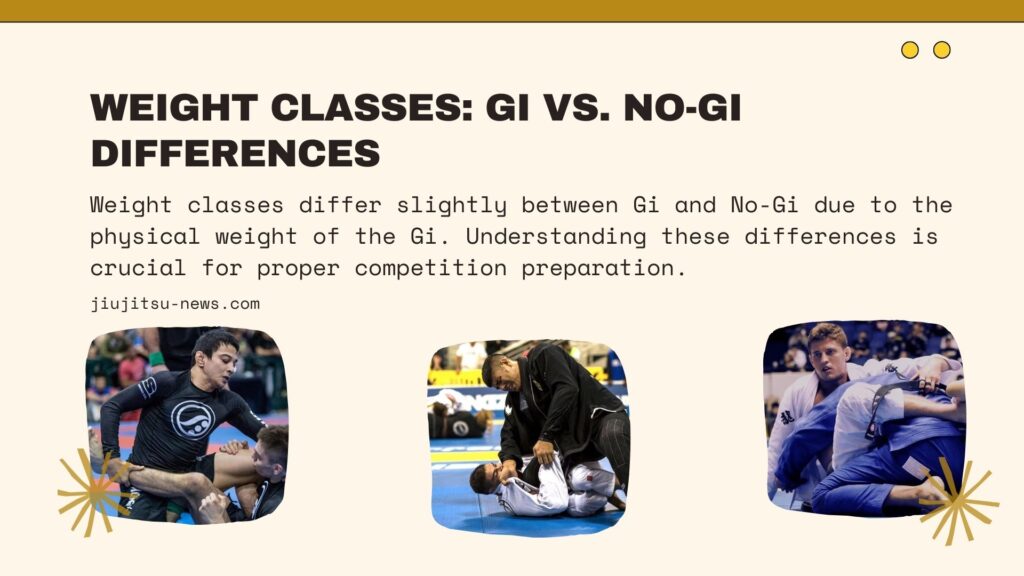
In IBJJF Gi competitions, the weight classes account for the added weight of the Gi, which typically ranges from 1.5 to 2.5 kilograms (approximately 3.3 to 5.5 pounds).
This additional weight affects the categorization, making Gi weight classes slightly heavier compared to No-Gi divisions.
When preparing for a Gi competition, consider the weight of the Gi when choosing a weight class to avoid being disqualified or at a disadvantage against heavier opponents.
Before entering a competition, it’s essential to consider the weight of your Gi when determining your weight class to avoid misclassification.
This is crucial for choosing the suitable weight class and adjusting your strategy, which will help you compete more effectively.
Curious about IBJJF age divisions? Explore our detailed guide and deepen your understanding of the age-based categories in Brazilian Jiu-Jitsu competitions. Whether you’re preparing to compete or love to learn, this article has everything you need. Check it out now!
Conclusion
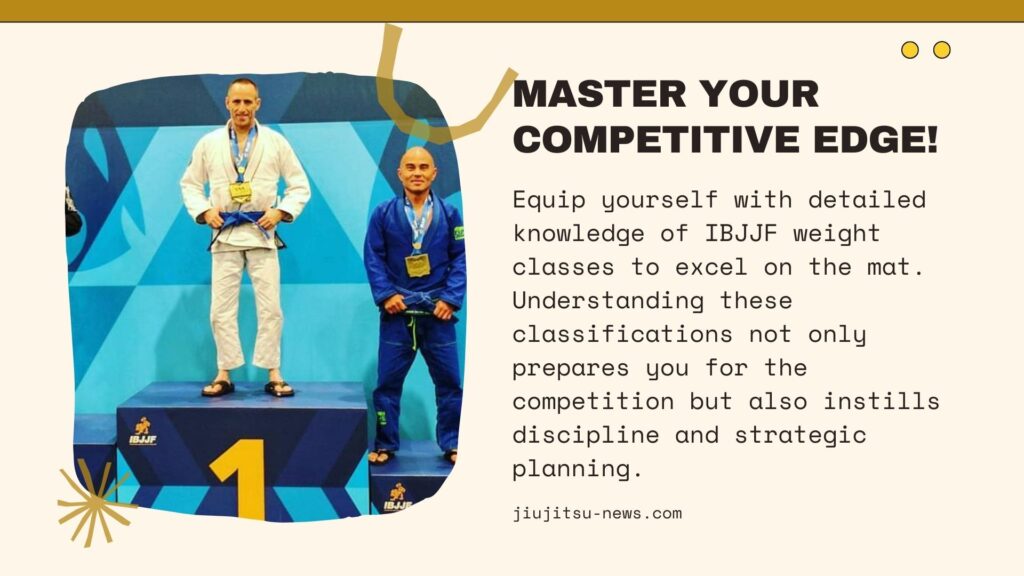
In the dynamic and disciplined world of Brazilian jiu-jitsu, understanding the IBJJF weight classes is more than just a necessity—it’s a strategic advantage.
Whether you’re a novice eager to make your mark or a seasoned practitioner aiming for the top, the detailed breakdown of weight divisions in both Gi and No-Gi categories equips you with the knowledge to navigate the complexities of competition.
As you step onto the mat, remember that each division is designed to ensure fairness and competitive integrity, allowing you to focus purely on showcasing your skills and tactics.
See Also! Dive into our interactive IBJJF Divisions Quiz and challenge yourself on everything from age and weight classes to rank divisions. Start Quiz Now!

